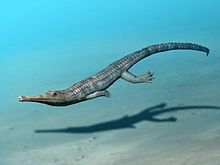Macrospondylus
| Macrospondylus Temporal range: Toarcian | |
|---|---|
 | |
| Macrospondylus bollensis, Holzmaden Germany | |
| Scientific classification | |
| Domain: | Eukaryota |
| Kingdom: | Animalia |
| Phylum: | Chordata |
| Class: | Reptilia |
| Clade: | Archosauria |
| Clade: | Pseudosuchia |
| Clade: | Crocodylomorpha |
| Clade: | Crocodyliformes |
| Suborder: | †Thalattosuchia |
| Superfamily: | †Teleosauroidea |
| Family: | †Machimosauridae |
| Genus: | †Macrospondylus von Meyer, 1831 |
| Species: | †M. bollensis |
| Binomial name | |
| †Macrospondylus bollensis Jäger, 1828 | |
| Synonyms | |
| |
Macrospondylus is an extinct genus of machimosaurid teleosauroid crocodyliform from the Early Jurassic (Toarcian) of Europe. Fossils are known from the Posidonia Shale of Germany, the Whitby Mudstone of the United Kingdom, and the "schistes bitumineux" of Luxembourg.
Evolutionary relationships[edit]

Macrospondylus has historically been synonymized with Steneosaurus.[1] A 2005 phylogenetic analysis of Thalattosuchia, however, did not support the monophyly of Steneosaurus, as the genera Machimosaurus and Teleosaurus both fell within Steneosaurus.[2] Reinforcing the paraphyly of Steneosaurus, Young et al. (2012), Ősi et al. (2018), and Wilberg et al. (2019) recovered Steneosaurus bollensis and other Steneosaurus species in disparate positions within Teleosauridae.[3][4][5]
In 2016, its length was estimated at 5.5 m (18 ft), making it the largest known Early Jurassic crocodylomorph.[6] In 2020, the genus was formally revived.[7]
See also[edit]
References[edit]
- ^ Steel R. 1973. Crocodylia. Handbuch der Paläoherpetologie, Teil 16. Stuttgart: Gustav Fischer Verlag,116 pp.
- ^ Mueller-Töwe, I. J. (2005). "Phylogenetic relationships of the Thalattosuchia" (PDF). Zitteliana. A45: 211–213.
- ^ Young, M. T.; Brusatte, S. L.; De Andrade, M. B.; Desojo, J. B.; Beatty, B. L.; Steel, L.; Fernández, M. S.; Sakamoto, M.; Ruiz-Omeñaca, J. I.; Schoch, R. R. (2012). Butler, Richard J, ed. "The Cranial Osteology and Feeding Ecology of the Metriorhynchid Crocodylomorph Genera Dakosaurus and Plesiosuchus from the Late Jurassic of Europe". PLoS ONE 7 (9): e44985. doi:10.1371/journal.pone.0044985. PMC 3445579. PMID 23028723. edit
- ^ Ősi A, Young MT, Galácz A, Rabi M. 2018. A new large-bodied thalattosuchian crocodyliform from the Lower Jurassic (Toarcian) of Hungary, with further evidence of the mosaic acquisition of marine adaptations in Metriorhynchoidea. PeerJ 6:e4668 https://doi.org/10.7717/peerj.4668
- ^ Eric W. Wilberg; Alan H. Turner; Christopher A. Brochu (2019). "Evolutionary structure and timing of major habitat shifts in Crocodylomorpha". Scientific Reports. 9 (1): Article number 514. doi:10.1038/s41598-018-36795-1. PMC 6346023. PMID 30679529.
- ^ Young, MT; Rabi, M.; Bell, MA; Foffa, D.; Steel, L.; Sachs, S.; Peyer, K. (2016). "Big-headed marine crocodyliforms and why we must be cautious when using extant species as body length proxies for long-extinct relatives". Palaeontologia Electronica. 19 (3): 1–14. doi:10.26879/648.
- ^ Johnson, Michela M.; Young, Mark T.; Brusatte, Stephen L. (2020). "The phylogenetics of Teleosauroidea (Crocodylomorpha, Thalattosuchia) and implications for their ecology and evolution". PeerJ. 8: e9808. doi:10.7717/peerj.9808. PMC 7548081. PMID 33083104.


 French
French Deutsch
Deutsch